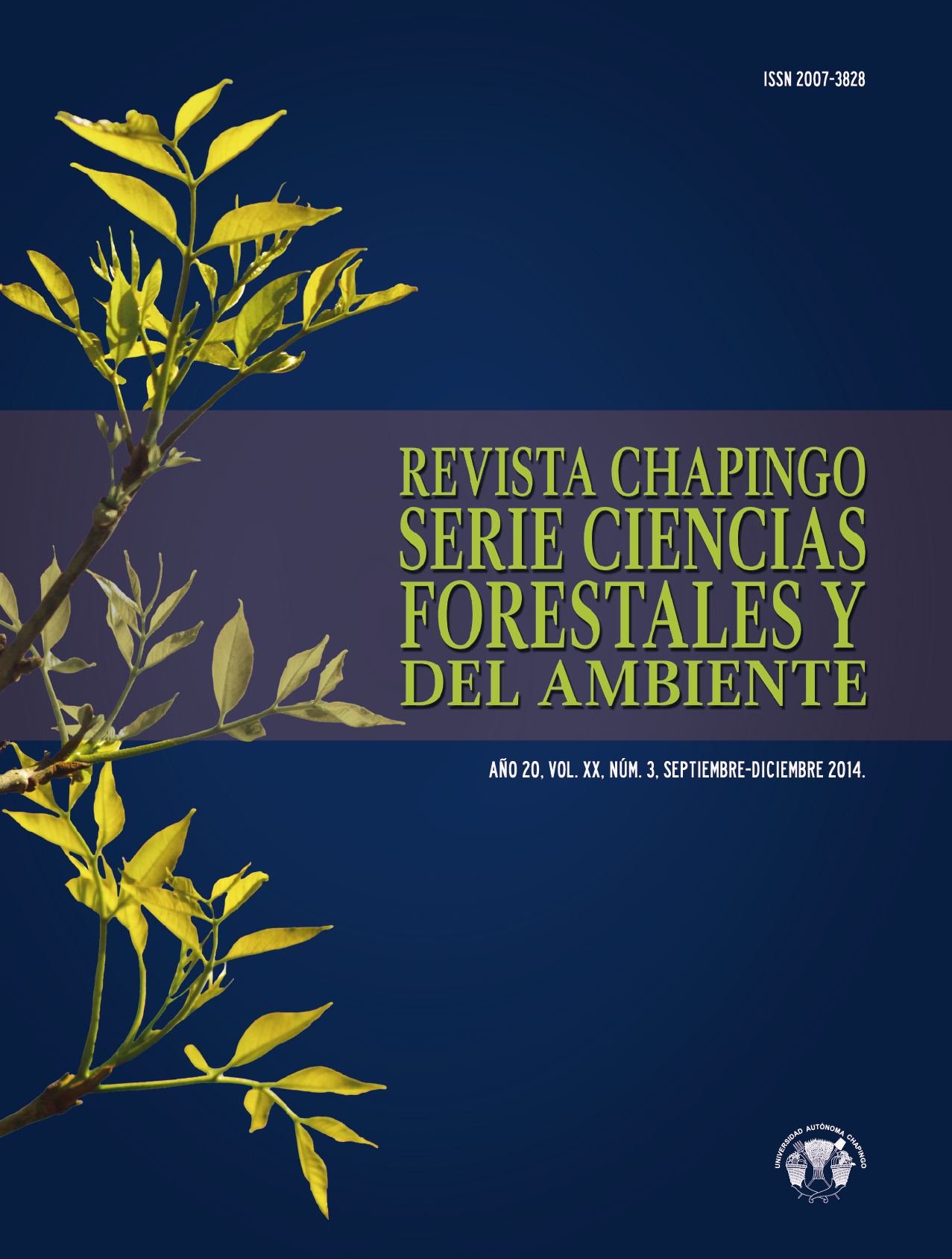Resumen
En el oriente de Michoacán, la muerte regresiva en plantaciones comerciales de eucalipto se presentó en árboles con daños por heladas y sequías en el 2013. En Eucalyptus nitens se aisló al patógeno Neofusicoccum eucalyptorum encontrando a su teleomorfo Botryosphaeria eucalyptorum en los cancros, mientras que N. parvum se aisló de E. nitens y E. globulus. Ambas especies de Neofusicoccum se identificaron por morfología y se caracterizaron molecularmente mediante PCR-ITS. Las secuencias de N. eucalyptorum (números de acceso: KC479184 y KC4799188) y N. parvum (KC479185, KC479186 y KC479187) se depositaron en el Banco de Genes del NCBI. En campo, los eucaliptos enfermos presentaron muerte regresiva, cancros fusiformes en fuste que inducen hinchamientos, flujo de resina y brotes epicórmicos. Los hongos inoculados in vitro en varetas de E. nitens y E. globulus causaron lesiones necróticas y abundantes picnidios inmaduros a 10 días después de la inoculación (ddi). En los árboles de E. nitens de tres años de edad se formó un cancro de apariencia hundida con forma fusiforme, de color café oscuro y de 13 a 21.9 cm a los 48 ddi. Este trabajo es el primer reporte de N. eucalyptorum y N. parvum en México causando enfermedad en plantaciones de eucalipto.
Citas
Barnett, H. L., & Hunter, B. B. (1998). Ilustrated genera of imperfect fungi (4th ed.). St Paul, Minnesota, USA: The American Phytopathological Society.
Burgess, T. I., Sakalidis, M. L., & Hardy, H. E. S. (2006). Gene flow of the canker pathogen Botryosphaeria australis between Eucalyptus globulus plantations and native eucalypt forests in Western Australia. Austral Ecology, 31, 559–666. doi: https://doi.org/10.1111/j.1442-9993.2006.01596.x
Cibrián, T. D. (2013). Manual para la identificación y manejo de plagas en plantaciones forestales. México: Universidad Autónoma Chapingo-CONAFOR-CONACYT.
Cibrián, T. D., Rosales, D. A., & García, D. S. E. (2007). Enfermedades forestales en México/Forest diseases in Mexico. México. Universidad Autónoma Chapingo-CONAFOR-SEMARNAT; Comisión Forestal de América del Norte, COFAN, FAO.
Comisión Nacional Forestal (CONAFOR). (2011). http://www.conafor.gob.mx/portal/index.php/temas-forestales/plantaciones
Crous, P. W., Slippers, B., Wingfield, M. J., Rheeder, J., Marasas, W. F. O., Philips, A. J. L.,….Groenewald, J. Z. (2006). Phylogenetic lineages in the Botryosphaeriaceae. Studies in Mycology, 55, 235–253. http://www.ncbi.nlm.nih.gov/pmc/articles/PMC2104729/pdf/0235.pdf
Cruz, A. J., Cibrián T. D., Ramírez M. H., & García D. S. E. (2001). Etiología y síndrome de los cancros Cryphonectria, Lasiodiplodia y Fusicoccum en eucalipto (Eucalyptus camaldulensis Dehnh). Revista Chapingo Serie Ciencias Forestales y del Ambiente, 7(1), 27–37. http://portal.chapingo.mx/revistas/forestales/contenido.php?id_ articulo=342&id_revistas=3
Gezahgne, A., Roux, J., Slippers, B., & Wingfield M. J. (2004). Identification of the causal agent of Botryosphaeria stem canker in Ethiopian eucalyptus plantations. South African Journal of Botany, 70(2), 241–248. http://www.fabinet.up.ac.za/publication/pdfs/585-2004_gezahgne_roux_slippers_wingfield_sa_j_bot.pdf
Iturritxa, E., Slippers, B. N., Mesanza, & Wingfield, M. J. (2011). First report of Neofusicoccum parvum causing canker and die-back of Eucalyptus in Spain Australasian Plant Disease Notes, 6, 57–59. doi: https://doi.org/10.1007/s13314-011-0019-5
Mohali, S., Slippers B. N., & Wingfield M. J. (2006). Two new Fusicoccum species from Acacia and Eucalyptus in Venezuela based on morphology and DNA sequence data. Mycological Research, 110, 405–413. doi: https://doi.org/10.1016/j.mycres.2006.01.006.
Molina-Gayosso, E., Silva-Rojas, H. V., García-Morales, S., & Ávila- Quezada, G. (2012). First report of black spots on avocado fruit caused by Neofusicoccum parvum in Mexico. Plant Disease, 96(2), 287.. doi: https://doi.org/10.1094/PDIS-08-11-0699
Pérez, C. A., Altier, N., Simeto, S., Wingfield, M. J., Slippers, B., & Blanchette, R. A. (2004). Botryosphaeriaceae from Eucalyptus and native Myrtaceae in Uruguay. Agrociencia, 12(2), 19–30. http://www.fagro.edu.uy/~agrociencia/index.php/directorio/article/viewFile/162/104
Pérez, C. A., Wingfield, M. J., Slippers, B., Altier, N. A., & Blanchette, R. A. (2009). Neofusicoccum eucalyptorum, a Eucalyptus pathogen, on native Myrtaceae in Uruguay. Plant Pathology, 58, 964–970.04 doi: https://doi.org/10.1111/j.1365-3059.2009.02116.x
Pérez, C. A., Wingfield, M. J., Slippers, B., Altier, N. A., & Blanchette, R. A. (2010). Endophytic and canker-associated Botryosphaeriaceae occurring on non-native Eucalyptus and native Myrtaceae trees in Uruguay. Fungal Diversity, 41, 53–69. doi: https://doi.org/10.1007/s13225-009-0014-8
Pérez-Vera, O. A., Yáñez-Morales, M. J., Alvarado-Rosales, D., Cibrián-Tovar, D., & García-Díaz, S. E. (2005). Hongos asociados a eucalipto, Eucalyptus grandis Hill: Maid. Agrociencia, 39, 311–318. http://www.colpos.mx/agrocien/Bimestral/2005/may-jun/art-8.pdf
Rodas, C. A., Slippers, B., Gryzenhout, M., & Wingfield, M. J. (2009). Botryosphaeriaceae associated with Eucalyptus canker diseases in Colombia. Forest Pathology, 39, 110–123. doi: https://doi.org/10.1111/j.1439-0329.2008.00569.x
Sakalidis, M. L., Hardy, G. E. St. J., & Burguess, T. I. (2011). Use of the Genealogical Sorting Index (GSI) to delineate species boundaries in the Neofusicoccum parvum-Neofusicoccum ribis species complex. Molecular Phylogenetics and Evolution, 60(320), 333–344. http://researchrepository.murdoch.edu.au/4559/1/use_of_the_Genealogical_Sorting_Index.pdf
Schoeneweiss, D. F. (1981). The role of environmental stress in diseases of woody plants. Plant Disease, 65, 308–314.df http://www.apsnet.org/publications/PlantDisease/BackIssues/Documents/1981Articles/PlantDisease65n04_308.PDF
Sivanesan, A. (1984). The bitunicate Ascomycetes and their anamorphs. USA: Lubrecht & Cramer.F
Slippers, B., Fourie, G., Crous, P. W., Coutinho, T. A., Wingfield, B. D., Carnegie, A. J., & Wingfield, M. J. (2004). Speciation and distribution of Botryosphaeria spp. on native and introduced Eucalyptus trees in Australia and South Africa. Studies in Mycology, 50, 343–358. http://www.fabinet.up.ac.za/publication/pdfs/661-004_slippers_fourie_crous_coutinho_wingfield_carnegie_wingfield_studies_mycol.pdf
Slippers, B., & Wingfield, M. J. (2007). Botryosphaeriaceae as endophytes and latent pathogens of woody plants: Diversity, ecology and impact. Fungal Biology Reviews, 21, 90–06. doi: https://doi.org/10.1016/j.fbr.2007.06.002
Smith, H., Crous, P. W., Wingfield, M. J., Coutinho T. A., & Wingfield, B. D. (2001). Botryosphaeria eucalyptorum sp. nov., a new species in the B. dothidea-complex on Eucalyptus in South Africa. Mycologia, 93(2), 277–285. http://www.jstor.org/discover/10.2307/3761649?uid=3738664&uid=2129&uid=2&uid=70&uid=4&sid=21103254300791
Statistical Analysis System (SAS). (2000). SAS system for Windows V8.1. Cary, NC. USA: SAS Institute.
Velázquez, M. A., Fierros, G. A. M., Aldrete, A., Gómez, G. A., Férnández, C. S., De los Santos, P. H.,…Ramírez, H. C. (2013). Situación actual y perspectivas de las plantaciones forestales comerciales en México. Comisión Nacional Forestal (CONAFOR).

Esta obra está bajo una licencia internacional Creative Commons Atribución-NoComercial 4.0.
Derechos de autor 2014 Revista Chapingo Serie Ciencias Forestales y del Ambiente



